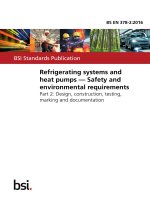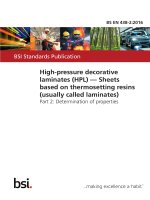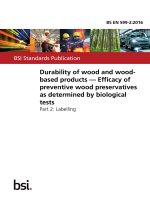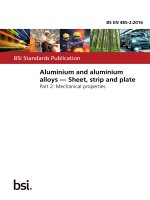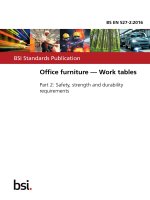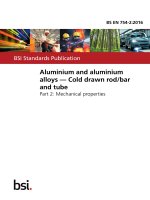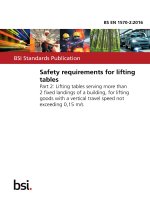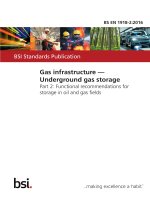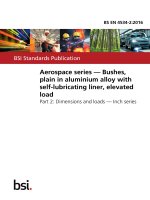Bsi bs en 61260 2 2016
Bạn đang xem bản rút gọn của tài liệu. Xem và tải ngay bản đầy đủ của tài liệu tại đây (2.21 MB, 32 trang )
BS EN 61260-2:2016
BSI Standards Publication
Electroacoustics —
Octave-band and
fractional-octave-band
filters
Part 2: Pattern-evaluation tests
BS EN 61260-2:2016 BRITISH STANDARD
National foreword
This British Standard is the UK implementation of EN 61260-2:2016. It is
identical to IEC 61260-2:2016. Together with BS EN 61260-1:2014 and BS
EN 61260-3:2016, it supersedes BS EN 61260:1996 which is withdrawn.
The UK participation in its preparation was entrusted to Technical
Committee EPL/29, Electroacoustics.
A list of organizations represented on this committee can be obtained on
request to its secretary.
This publication does not purport to include all the necessary provisions of
a contract. Users are responsible for its correct application.
© The British Standards Institution 2016.
Published by BSI Standards Limited 2016
ISBN 978 0 580 84839 1
ICS 17.140.50
Compliance with a British Standard cannot confer immunity from
legal obligations.
This British Standard was published under the authority of the
Standards Policy and Strategy Committee on 30 June 2016.
Amendments/corrigenda issued since publication
Date Text affected
EUROPEAN STANDARD BS EN 61260-2:2016
NORME EUROPÉENNE
EUROPÄISCHE NORM EN 61260-2
ICS 17.140.50 June 2016
Supersedes EN 61260:1995 (partially)
English Version
Electroacoustics - Octave-band and fractional-octave-band filters
- Part 2: Pattern-evaluation tests
(IEC 61260-2:2016)
Electroacoustique - Filtres de bande d'octave et de bande Elektroakustik - Bandfilter für Oktaven und Bruchteile von
d'une fraction d'octave - Partie 2: Essais d'évaluation d'un Oktaven - Teil 2: Baumusterprüfung
(IEC 61260-2:2016)
modèle
(IEC 61260-2:2016)
This European Standard was approved by CENELEC on 2016-04-27. CENELEC members are bound to comply with the CEN/CENELEC
Internal Regulations which stipulate the conditions for giving this European Standard the status of a national standard without any alteration.
Up-to-date lists and bibliographical references concerning such national standards may be obtained on application to the CEN-CENELEC
Management Centre or to any CENELEC member.
This European Standard exists in three official versions (English, French, German). A version in any other language made by translation
under the responsibility of a CENELEC member into its own language and notified to the CEN-CENELEC Management Centre has the
same status as the official versions.
CENELEC members are the national electrotechnical committees of Austria, Belgium, Bulgaria, Croatia, Cyprus, the Czech Republic,
Denmark, Estonia, Finland, Former Yugoslav Republic of Macedonia, France, Germany, Greece, Hungary, Iceland, Ireland, Italy, Latvia,
Lithuania, Luxembourg, Malta, the Netherlands, Norway, Poland, Portugal, Romania, Slovakia, Slovenia, Spain, Sweden, Switzerland,
Turkey and the United Kingdom.
European Committee for Electrotechnical Standardization
Comité Européen de Normalisation Electrotechnique
Europäisches Komitee für Elektrotechnische Normung
CEN-CENELEC Management Centre: Avenue Marnix 17, B-1000 Brussels
© 2016 CENELEC All rights of exploitation in any form and by any means reserved worldwide for CENELEC Members.
Ref. No. EN 61260-2:2016 E
BS EN 61260-2:2016
EN 61260-2:2016
European foreword
The text of document 29/845/CDV, future edition 1 of IEC 61260-2, prepared by IEC TC 29,
Electroacoustics, was submitted to the IEC-CENELEC parallel vote and was approved by CENELEC as
EN 61260-2:2016.
The following dates are fixed:
• latest date by which the document has (dop) 2017-01-27
to be implemented at national level by (dow) 2019-04-27
publication of an identical national
standard or by endorsement
• latest date by which the national
standards conflicting with the
document have to be withdrawn
This document supersedes EN 61260:1995.
Attention is drawn to the possibility that some of the elements of this document may be the subject of
patent rights. CENELEC [and/or CEN] shall not be held responsible for identifying any or all such patent
rights.
Endorsement notice
The text of the International Standard IEC 61260-2:2016 was approved by CENELEC as a European
Standard without any modification.
2
BS EN 61260-2:2016
EN 61260-2:2016
Annex ZA
(normative)
Normative references to international publications
with their corresponding European publications
The following documents, in whole or in part, are normatively referenced in this document and are
indispensable for its application. For dated references, only the edition cited applies. For undated
references, the latest edition of the referenced document (including any amendments) applies.
NOTE 1 When an International Publication has been modified by common modifications, indicated by (mod), the relevant EN/HD
applies.
NOTE 2 Up-to-date information on the latest versions of the European Standards listed in this annex is available here:
www.cenelec.eu.
Publication Year Title EN/HD Year
2009
IEC 61000-4-2 2008 Electromagnetic compatibility (EMC) -- Part EN 61000-4-2 2006
4-2: Testing and measurement techniques - 2014
Electrostatic discharge immunity test -
IEC 61000-4-3 2006 Electromagnetic compatibility (EMC) -- Part EN 61000-4-3 2005
2005
4-3: Testing and measurement techniques - -
Radiated, radio-frequency, electromagnetic 2014
-
field immunity test -
-
IEC 61000-4-6 2013 Electromagnetic compatibility (EMC) -- Part EN 61000-4-6 -
-
4-6: Testing and measurement techniques -
-
Immunity to conducted disturbances,
induced by radio-frequency fields
IEC 61000-6-1 - Electromagnetic compatibility (EMC) -- Part EN 61000-6-1
6-1: Generic standards - Immunity for
residential, commercial and light-industrial
environments
IEC 61000-6-2 2005 Electromagnetic compatibility (EMC) -- Part EN 61000-6-2
- - 6-2: Generic standards - Immunity for
IEC 61000-6-3 -
industrial environments
+ corrigendum Sep.
Electromagnetic compatibility (EMC) -- Part EN 61000-6-3
6-3: Generic standards - Emission standard
for residential, commercial and light-
industrial environments
IEC 61260-1 2014 Electroacoustics - Octave-band and EN 61260-1
fractional-octave-band filters -- Part 1:
Specifications
IEC 61672-1 - Electroacoustics - Sound level meters -- PartEN 61672-1
1: Specifications
ISO/IEC Guide 98-3 - Uncertainty of measurement - Part 3: Guide -
to the expression of uncertainty in
measurement (GUM:1995)
ISO/IEC Guide 98-4 - Uncertainty of measurement_- Part_4: Role -
of measurement uncertainty in conformity
assessment
ISO/IEC Guide 99 - International vocabulary of metrology - Basic-
and general concepts and associated terms
(VIM)
CISPR 16-1-1 - Specification for radio disturbance and -
immunity measuring apparatus and methods
- Part 1-1: Radio disturbance and immunity
measuring apparatus - Measuring appartus
CISPR 16-1-2 - Specification for radio disturbance and EN 55016-1-2
immunity measuring apparatus and methods
- Part 1-2: Radio disturbance and immunity
measuring apparatus - Coupling devices for
conducted disturbance measurements
3
BS EN 61260-2:2016
EN 61260-2:2016
CISPR 16-2-1 - Specification for radio disturbance and EN 55016-2-1 -
immunity measuring apparatus and methods
- Part 2-1: Methods of measurement of
disturbances and immunity - Conducted
disturbance measurements
CISPR 16-2-3 - Specification for radio disturbance and EN 55016-2-3 -
immunity measuring apparatus and methods
-- Part 2-3: Methods of measurement of
disturbances and immunity - Radiated
disturbance measurements
CISPR 22 - Information technology equipment - Radio EN 55022 -
disturbance characteristics - Limits and
methods of measurement
4
– 2 – BS EN 61260-2:2016
IEC 61260-2:2016 © IEC 2016
CONTENTS
FOREWORD.........................................................................................................................3
INTRODUCTION ................................................................................................................... 5
1 Scope............................................................................................................................6
2 Normative references.....................................................................................................6
3 Terms and definitions ....................................................................................................7
4 Submission for testing ...................................................................................................7
5 Marking of the filter and information in the instruction manual .........................................7
6 Mandatory facilities and general requirements ................................................................8
6.1 General.................................................................................................................8
6.2 Test instruments ...................................................................................................9
7 Tests at reference conditions .......................................................................................10
7.1 General...............................................................................................................10
7.2 Relative attenuation, effective bandwidth deviation and summation of output
signals ................................................................................................................10
7.2.1 General .......................................................................................................10
7.2.2 Relative attenuation .....................................................................................11
7.2.3 Effective bandwidth deviation .......................................................................11
7.2.4 Summation of output signals ........................................................................11
7.3 Linear operating range, measurement range, level range control and
overload indicator................................................................................................12
7.4 Time-invariant operation......................................................................................13
7.5 Power supply check ............................................................................................13
8 Electromagnetic and electrostatic compatibility requirements ........................................14
8.1 General...............................................................................................................14
8.2 Influence of electrostatic discharges ....................................................................14
8.3 Influence of AC power-frequency and radio-frequency fields ................................14
8.3.1 Input signal ..................................................................................................14
8.3.2 Range setting ..............................................................................................14
8.3.3 AC power-frequency tests ............................................................................14
8.3.4 Radio-frequency tests ..................................................................................15
8.4 Radio-frequency emissions and public power supply disturbances........................16
9 Sensitivity to ambient air temperature and relative humidity ..........................................17
10 Pattern-evaluation report .............................................................................................17
Annex A (informative) Uncertainty related to test by sinusoidal sweeps ...............................19
A.1 General...............................................................................................................19
A.2 Digitally generated signal ....................................................................................19
A.3 Test signal from a signal generator ......................................................................20
A.4 Comparing measurements ...................................................................................21
Annex B (informative) Test of time invariant operation with the use of an exponential
sweep – Example................................................................................................................22
B.1 General...............................................................................................................22
B.2 Example..............................................................................................................22
Bibliography .......................................................................................................................24
BS EN 61260-2:2016 – 3 –
IEC 61260-2:2016 © IEC 2016
INTERNATIONAL ELECTROTECHNICAL COMMISSION
____________
ELECTROACOUSTICS – OCTAVE-BAND
AND FRACTIONAL-OCTAVE-BAND FILTERS –
Part 2: Pattern-evaluation tests
FOREWORD
1) The International Electrotechnical Commission (IEC) is a worldwide organization for standardization comprising
all national electrotechnical committees (IEC National Committees). The object of IEC is to promote
international co-operation on all questions concerning standardization in the electrical and electronic fields. To
this end and in addition to other activities, IEC publishes International Standards, Technical Specifications,
Technical Reports, Publicly Available Specifications (PAS) and Guides (hereafter referred to as “IEC
Publication(s)”). Their preparation is entrusted to technical committees; any IEC National Committee interested
in the subject dealt with may participate in this preparatory work. International, governmental and non-
governmental organizations liaising with the IEC also participate in this preparation. IEC collaborates closely
with the International Organization for Standardization (ISO) in accordance with conditions determined by
agreement between the two organizations.
2) The formal decisions or agreements of IEC on technical matters express, as nearly as possible, an international
consensus of opinion on the relevant subjects since each technical committee has representation from all
interested IEC National Committees.
3) IEC Publications have the form of recommendations for international use and are accepted by IEC National
Committees in that sense. While all reasonable efforts are made to ensure that the technical content of IEC
Publications is accurate, IEC cannot be held responsible for the way in which they are used or for any
misinterpretation by any end user.
4) In order to promote international uniformity, IEC National Committees undertake to apply IEC Publications
transparently to the maximum extent possible in their national and regional publications. Any divergence
between any IEC Publication and the corresponding national or regional publication shall be clearly indicated in
the latter.
5) IEC itself does not provide any attestation of conformity. Independent certification bodies provide conformity
assessment services and, in some areas, access to IEC marks of conformity. IEC is not responsible for any
services carried out by independent certification bodies.
6) All users should ensure that they have the latest edition of this publication.
7) No liability shall attach to IEC or its directors, employees, servants or agents including individual experts and
members of its technical committees and IEC National Committees for any personal injury, property damage or
other damage of any nature whatsoever, whether direct or indirect, or for costs (including legal fees) and
expenses arising out of the publication, use of, or reliance upon, this IEC Publication or any other IEC
Publications.
8) Attention is drawn to the Normative references cited in this publication. Use of the referenced publications is
indispensable for the correct application of this publication.
9) Attention is drawn to the possibility that some of the elements of this IEC Publication may be the subject of
patent rights. IEC shall not be held responsible for identifying any or all such patent rights.
International Standard IEC 61260-2 has been prepared by IEC technical committee 29:
Electroacoustics.
This first edition of IEC 61260-2 (together with IEC 61260-1:2014 and IEC 61260-3:2016),
cancels and replaces the first edition of IEC 61260 published in 1995 and its Amendment 1
published in 2001. This edition constitutes a technical revision.
This edition includes the following significant technical changes with respect to IEC 61260.
a) The single document in the first edition of IEC 61260:1995 is now separated into three
parts of the IEC 61260 series covering: specifications, pattern-evaluation tests and
periodic tests.
b) IEC 61260:1995 specified three performance categories: class 0, 1 and 2 while the
IEC 61260 series specifies requirements for class 1 and 2.
c) In IEC 61260:1995, the design goals for the specification can be based on base-2 or base-
10 design. In the IEC 61260 series only base-10 is specified.
– 4 – BS EN 61260-2:2016
IEC 61260-2:2016 © IEC 2016
d) The reference environmental conditions have been changed from 20 °C/65 % RH to
23 °C/50 % RH;
e) IEC 61260:1995 specified tolerance limits without considering the uncertainty of
measurement for verification of the specifications. The IEC 61260 series specifies
acceptance limits for the observed values and maximum-permitted uncertainty of
measurements for laboratories testing conformance to specifications in the standard.
The text of this standard is based on the following documents:
CDV Report on voting
29/845/CDV 29/881A/RVC
Full information on the voting for the approval of this standard can be found in the report on
voting indicated in the above table.
This publication has been drafted in accordance with the ISO/IEC Directives, Part 2.
A list of all the parts of the IEC 61260 series, published under the general title
Electroacoustics – Octave-band and fractional-octave-band filters can be found on the IEC
website.
The committee has decided that the contents of this publication will remain unchanged until
the stability date indicated on the IEC website under "" in the data
related to the specific publication. At this date, the publication will be
• reconfirmed,
• withdrawn,
• replaced by a revised edition, or
• amended.
BS EN 61260-2:2016 – 5 –
IEC 61260-2:2016 © IEC 2016
INTRODUCTION
IEC 61260:1995 and IEC 61260:1995/AMD 1:2001 are now separated into the following three
parts of IEC 61260 series:
• Part 1: Specifications
• Part 2: Pattern-evaluation tests
• Part 3: Periodic tests
For assessments of conformance to performance specifications, IEC 61260-1 uses different
criteria than were used for the IEC 61260:1995 edition.
IEC 61260:1995 did not provide any requirements or recommendations to account for the
uncertainty of measurement in assessments of conformance to specifications. This absence
of requirements or recommendations to account for uncertainty of measurement created
ambiguity in determinations of conformance to specifications for situations where a measured
deviation from a design goal was close to the limit of the allowed deviation. If conformance
was determined based on whether a measured deviation did or did not exceed the limits, the
end-user of the octave-band and fractional-octave-band filters incurred the risk that the true
deviation from a design goal exceeded the limits.
To remove this ambiguity, IEC Technical Committee 29, at its meeting in 1996, adopted a
policy to account for measurement uncertainty in assessments of conformance in International
Standards that it prepares.
This edition of IEC 61260-2 uses an amended criterion for assessing conformance to a
specification. Conformance is demonstrated when (a) measured deviations from design goals
do not exceed the applicable acceptance limits and (b) the uncertainty of measurement does
not exceed the corresponding maximum-permitted uncertainty. Acceptance limits are
analogous to the tolerance limits allowances for design and manufacturing implied in the
IEC 61260:1995.
Actual and maximum-permitted uncertainties of measurement are determined for a coverage
probability of 95 %. Unless more specific information is available, the evaluation of the
contribution of a specific filter or filter set to a total measurement uncertainty can be based on
the acceptance limits and maximum-permitted uncertainties specified in this standard.
– 6 – BS EN 61260-2:2016
IEC 61260-2:2016 © IEC 2016
ELECTROACOUSTICS – OCTAVE-BAND
AND FRACTIONAL-OCTAVE-BAND FILTERS –
Part 2: Pattern-evaluation tests
1 Scope
1.1 This part of IEC 61260 provides details of the tests necessary to verify conformance to
all mandatory specifications given in IEC 61260-1:2014 for octave-band and fractional-octave-
band filters.
1.2 Tests and test methods are applicable to class 1 and class 2 bandpass filters. The aim
is to ensure that all testing laboratories use consistent methods to perform pattern-evaluation
tests.
2 Normative references
The following documents, in whole or in part, are normatively referenced in this document and
are indispensable for its application. For dated references, only the edition cited applies. For
undated references, the latest edition of the referenced document (including any
amendments) applies.
IEC 61000-4-2:2008, Electromagnetic compatibility (EMC) – Part 4-2: Testing and
measurement techniques – Electrostatic discharge immunity test
IEC 61000-4-3:2006, Electromagnetic compatibility (EMC) – Part 4-3: Testing and
measurement techniques – Radiated, radio-frequency, electromagnetic field immunity test
IEC 61000-4-6:2013, Electromagnetic compatibility (EMC) – Part 4-6: Testing and
measurement techniques – Immunity to conducted disturbances, induced by radio-frequency
fields
IEC 61000-6-1, Electromagnetic compatibility (EMC) – Part 6-1: Generic standards –
Immunity for residential, commercial and light-industrial environments
IEC 61000-6-2:2005, Electromagnetic compatibility (EMC) – Part 6-2: Generic standards –
Immunity for industrial environments
IEC 61000-6-3, Electromagnetic compatibility (EMC) – Part 6-3: Generic standards –
Emission standard for residential, commercial and light-industrial environments
IEC 61260-1:2014, Electroacoustics – Octave-band and fractional-octave-band filters – Part 1:
Specifications
IEC 61672-1, Electroacoustics – Sound level meters – Part 1: Specifications
CISPR 16-1-1, Specification for radio disturbance and immunity measuring apparatus and
methods – Part 1-1: Radio disturbance and immunity measuring apparatus – Measuring
apparatus
BS EN 61260-2:2016 – 7 –
IEC 61260-2:2016 © IEC 2016
CISPR 16-1-2, Specification for radio disturbance and immunity measuring apparatus and
methods – Part 1-2: Radio disturbance and immunity measuring apparatus – Coupling devices
for conducted disturbance measurements
CISPR 16-2-1, Specification for radio disturbance and immunity measuring apparatus and
methods – Part 2-1: Methods of measurement of disturbances and immunity – Conducted
disturbance measurements
CISPR 16-2-3, Specification for radio disturbance and immunity measuring apparatus and
methods – Part 2-3: Methods of measurement of disturbances and immunity – Radiated
disturbance measurements
CISPR 22:2008, Information technology equipment – Radio disturbance characteristics –
Limits and methods of measurement
ISO/IEC Guide 98-3, Uncertainty of measurement – Part 3: Guide to the expression of
uncertainty in measurement (GUM:1995)
ISO/IEC Guide 98-4, Uncertainty of measurement – Part 4: Role of measurement uncertainty
in conformity assessment
ISO/IEC Guide 99, International vocabulary of metrology – Basic and general concepts and
associated terms (VIM)
3 Terms and definitions
For the purposes of this document, the terms and definitions given in IEC 61260-1:2014,
IEC 61000-4-2, IEC 61000-4-3, IEC 61000-6-1, IEC 61000-6-2, and IEC 61000-6-3,
ISO/IEC Guide 98-3, ISO/IEC Guide 98-4 and ISO/IEC Guide 99 apply.
4 Submission for testing
4.1 At least three specimens of the same pattern of bandpass filter shall be submitted for
pattern-evaluation testing. As a minimum, the testing laboratory shall select two of the
specimens for testing. At least one of the two specimens shall then be tested fully according
to the procedures of this standard. The testing laboratory shall decide whether the full tests
shall also be performed on the second specimen or whether limited testing is adequate to
approve the pattern.
4.2 An instruction manual and all items or accessories that are identified in the instruction
manual as integral components for the normal mode of operation shall be submitted along
with the filters.
4.3 If the manufacturer of the filters supplies devices that are to be connected to the
bandpass filter by cables for a typical mode of operation for the filter, then the devices and
cables shall be submitted with the filter.
5 Marking of the filter and information in the instruction manual
5.1 It shall be verified that the filter is marked according to the requirements of
IEC 61260-1:2014.
5.2 It shall be verified that the instruction manual contains all the information that is
required by IEC 61260-1:2014 as relevant to the facilities provided by the filter.
– 8 – BS EN 61260-2:2016
IEC 61260-2:2016 © IEC 2016
5.3 If the filter does not conform to the requirements of 5.1 and 5.2, no pattern-evaluation
tests shall be performed.
5.4 After completion of all tests, the information shall be reviewed to ensure that it is
correct and that no applicable acceptance limits are exceeded.
6 Mandatory facilities and general requirements
6.1 General
6.1.1 No test specified in this part of IEC 61260 series shall be omitted unless the
bandpass filter does not possess the feature described for the test. When the design of a
fractional-octave-band filter, which has been pattern approved, is changed and a new pattern
approval is requested, then – at the discretion of the testing laboratory – it is not necessary to
repeat those tests for performance characteristics that are not affected by the design change.
6.1.2 If the filter does not possess the mandatory features listed in IEC 61260-1:2014,
such as overload indicator or means to check that the power supply is adequate for battery
powered instruments which contain the filter, the filter does not conform to the specifications
of IEC 61260-1:2014, and no pattern-evaluation tests shall be performed.
6.1.3 For all pattern-evaluation tests, the configuration of the filter shall be as specified in
the instruction manual for one of the normal modes of operation, including required
accessories. All configurations of the filter that are stated in the instruction manual as
conforming to the requirements of IEC 61260-1:2014 shall be tested.
6.1.4 If the instruction manual states that the filter conforms to the specifications of
IEC 61260-1:2014 with optional facilities installed, the combination with the optional facilities
installed shall also be tested to verify conformance to the relevant specifications.
6.1.5 If the filter is enclosed in an instrument containing a level detector and a display
device for displaying the level of the filtered signal with a resolution of at least 0,1 dB, the
displayed value from this display device shall be used for testing, if appropriate. If an
electrical output is provided corresponding to the displayed value and the testing laboratory
intends to utilize the electrical output instead of the display device, the laboratory shall verify
that changes in the levels of applied electrical input signals produce corresponding changes
in the signal levels indicated on the display device and at the electrical output that are in
accordance with the specifications of IEC 61260-1:2014.
6.1.6 For bandpass filters that are designed to operate with measuring devices that comply
with the requirements for sound level meters as specified in IEC 61672-1, the display
indicator of this device shall be used to measure the level of the output signal from the filter
set.
6.1.7 For filter sets with digital readout devices, or with output that is available in a
manufacturer-specified digital format (for example over a digital interface connection), the
level of the output should be determined from the numeric readout or via the digital output to
a suitable display or recording device. Where multiple outputs are present, if an output is
specified in the instruction manual for testing, this output shall be used for the pattern-
evaluation tests.
6.1.8 If the instruction manual specifies a procedure for adjusting the filter, e.g. sensitivity
adjustment, this procedure shall be followed before any measurements are performed.
6.1.9 For all tests, the filter shall be powered from its preferred supply. If the instruction
manual specifies requirements for the internal batteries, such batteries shall be installed for
the pattern-evaluation tests.
BS EN 61260-2:2016 – 9 –
IEC 61260-2:2016 © IEC 2016
6.1.10 The filter shall be allowed to reach equilibrium with the prevailing environmental
conditions before switching on the power to perform a test.
6.1.11 If the filter has more than one signal-processing channel, pattern-evaluation tests
shall be performed for each channel that utilizes unique signal processing techniques. For
multi-channel systems with the same functional equivalence in all channels, the number of
channels to be tested may be less than the total number of channels, at the discretion of the
testing laboratory.
6.1.12 Conformance to a performance specification is demonstrated when the following
criteria are both satisfied:
a) the measured deviation from the design goal does not exceed the applicable acceptance
limit and;
b) the corresponding uncertainty of measurement does not exceed the corresponding
maximum-permitted uncertainty of measurement given in IEC 61260-1:2014 for the same
coverage probability of 95 %.
IEC 61260-1:2014 gives example assessments of conformance using these criteria.
6.1.13 Laboratories performing pattern-evaluation tests shall calculate all uncertainties of
measurements in accordance with the guidelines given in the ISO/IEC Guide 98-3. Actual
measurement uncertainties shall be calculated for a coverage probability of 95 %. Calculation
of the actual measurement uncertainty for a particular test should consider at least the
following components, as applicable:
• the uncertainty attributed to calibration of the individual instruments and equipment used
to perform the test;
• the uncertainty resulting from environmental effects;
• the uncertainty resulting from errors that may be present in the applied signals;
• the uncertainty attributed to effects associated with the repeatability of the results of the
measurements. When a laboratory is only required to perform a single measurement, it is
necessary for the laboratory to make an estimate of the contribution of random effects to
the total uncertainty. The estimate should be determined from an evaluation of several
measurement results previously obtained for a similar filter and parameter;
• the uncertainty associated with the resolution of the display device used to display the
response from the filter. For digital display devices that indicate signal levels with a
resolution of 0,1 dB, the uncertainty component should be taken as a rectangular
distribution with semi-range of 0,05 dB.
6.1.14 If the uncertainty of measurement exceeds the maximum-permitted uncertainty of
measurement, the result of the test shall not be used to demonstrate conformance to a
specification, and pattern approval shall not be granted.
6.1.15 As appropriate, the laboratory shall utilize the recommendations given in the
instruction manual for performing the pattern-evaluation tests.
6.2 Test instruments
6.2.1 The laboratory shall use instruments with valid calibrations for the appropriate
quantities. The calibrations shall be traceable to national standards, as required.
6.2.2 Most of the required tests utilize steady sinusoidal signals of various frequencies and
signal levels. Sinusoidal signals for test of filter attenuation shall have a total distortion of not
more than 0,01 % for class 1 filters and not more than 0,03 % for class 2 filters. The total
distortion for sinusoidal signals for other tests shall not exceed 0,1 %.
– 10 – BS EN 61260-2:2016
IEC 61260-2:2016 © IEC 2016
6.2.3 Tests for time invariant operation use a constant amplitude sinusoidal signal the
frequency of which is varied, or swept, at an exponential rate. The effect on the deviation of
the measured time-averaged output signal level from the uncertainty in the amplitude and
sweep-rate for the determination of time-invariant operation shall be determined. The
expanded uncertainty shall not exceed the values given in IEC 61260-1:2014, Annex B.
NOTE The informative Annex A gives examples of how such uncertainties may be obtained.
6.2.4 Instruments for measuring the environmental conditions during the tests shall have
an expanded uncertainty not exceeding 0,5°C for temperature and 3 % for humidity.
7 Tests at reference conditions
7.1 General
7.1.1 All tests at reference conditions except test for electromagnetic and electrostatic
compatibility shall be made within the temperature range 20 °C to 26 °C and within the range
for relative humidity 35 % to 65 %.
7.1.2 The filter shall be permitted to acclimatize at the reference environmental condition
for at least 6 h.
7.1.3 The measured values of temperature and humidity shall be extended with the actual
expanded uncertainty of measurement and shall not exceed the specified range. It is assum-
ed that the influence from changes in the atmospheric pressure is insignificant compared to
the sensitivity to other environmental parameters. If this is not the case, the observation shall
be reported.
7.2 Relative attenuation, effective bandwidth deviation and summation of output
signals
7.2.1 General
7.2.1.1 The measurement of relative attenuation, effective bandwidth deviation and
summation of output signals are made by the same set of measurements using the response
to constant amplitude sinusoidal signals at various frequencies.
7.2.1.2 The measurement shall be performed on the reference level range. The level of
the input signals shall be (1 ± 0,1) dB below the specified upper boundary of the linear
operating range.
7.2.1.3 With the input and output of the instrument terminated, if appropriate, with the
impedances specified by the manufacturer, a steady sinusoidal signal is applied to the input
of the filter set. The relative attenuation at appropriate frequencies is measured.
7.2.1.4 The frequencies of the sinusoidal test signal for one filter are spaced at equal
intervals on a logarithmic scale centred on the exact midband frequency. If S is the number of
test frequencies per filter bandwidth, the normalized frequency Ωi of the i-th test signal is
determined from:
i
Ωi = G b⋅S (1)
where
i is a positive or negative integer, including zero. The number of test frequencies per filter
bandwidth, S, shall be not less than 24. G and b are, as defined in IEC 61260-1:2014, the
octave frequency ratio and the inverse of the bandwidth designator.
BS EN 61260-2:2016 – 11 –
IEC 61260-2:2016 © IEC 2016
NOTE If the filter consists of a set of filters operating in parallel (real time analysers), it will normally be suitable
to measure the response to a particular frequency for all filter bands simultaneously and store the result for further
calculations.
7.2.2 Relative attenuation
7.2.2.1 The relative attenuation ∆A(Ω) at any frequency is determined from Formula (8)
given in IEC 61260-1:2014. The measured relative attenuation shall not exceed the
acceptance limits given in section 5.10 of the same standard.
7.2.2.2 The relative attenuation shall be measured from 0,5 times the exact midband
frequency of the filter in the set with the lowest midband frequency, to 1,5 times the midband
frequency of the filter in the set with the highest midband frequency.
7.2.2.3 Deviation between actual and requested frequency shall be considered when
stating the uncertainty for testing of relative attenuation.
7.2.3 Effective bandwidth deviation
7.2.3.1 The effective bandwidth, Be, shall be determined from Formulas (13) and (14)
given in IEC 61260-1:2014, based on numerical evaluation of the integral expression in
Formula (14) of the same standard for normalized effective bandwidth.
7.2.3.2 For each filter in a filter set, the recommended procedure for numerical integration
of Formula (14) of IEC 61260-1:2014 is by the trapezoidal rule for summation of elemental
areas according to:
= Be ∑ 10 + 10 N 2 1 -0,1∆A(Ωi ) -0,1∆A(Ωi+1) [Ωi+1 - Ωi ] (2)
i=-N Ωi + Ωi+1 2
where is the relative attenuation in decibels measured at the i-th normalized test
∆A(Ωi) frequency;
N is an integer equal to or greater than 2 × S for any filter bandwidth and accuracy
class as long as the frequencies are within the limits in 7.2.2.2.
7.2.3.3 The measured effective bandwidth deviation shall not exceed the acceptance limits
given in 5.12 in IEC 61260-1:2014.
7.2.4 Summation of output signals
7.2.4.1 Let j identify a filter in a set of filters with j-1 and j+1 representing the contiguous
filters with midband frequencies lower and higher than for the j-th filter. Let ∆Aj, ∆Aj – 1 and
∆Aj + 1 represent measured relative attenuations of the three filters, respectively, at any test
frequency.
7.2.4.2 With S equal to the number of test frequencies per filter bandwidth from the relative
attenuation tests, let M be equal to the largest integer just less than or equal to S/2 and let i
be any integer between –M and +M to determine a frequency for a measurement of relative
attenuation.
i
7.2.4.3 At any normalized frequency, Ω=i fi G b⋅S , between the lower and upper
=fm
bandedge normalized frequencies of the j – th filter with exact midband frequency, fm, the
difference ∆Pj(Ωi) between the input signal level minus the reference attenuation and the level
of the summed output signals is determined from the relationship:
∆Pj= (Ωi ) 10 lg 10-0,1∆Aj-1 + 10-0,1∆Aj + 10-0,1∆Aj+1 dB (3)
– 12 – BS EN 61260-2:2016
IEC 61260-2:2016 © IEC 2016
where is the relative attenuation measured for filter (j – 1) at normalized frequency for
∆Aj–1 that filter G[i/(bS) + 1/b];
is the relative attenuation for filter j measured at normalized frequency G[i/(bS)];
∆Aj is the relative attenuation for filter (j + 1) measured at normalized frequency for
∆Aj + 1 that filter G[i/(bS) – 1/b].
7.2.4.4 The test shall be carried out from the filter with index j corresponding to the filter
adjacent to the filter with the lowest midband frequency to the filter adjacent to the filter with
the highest midband frequency in the set of filters.
7.2.4.5 For any filter bandwidth provided, the difference ∆Pj(Ωi) calculated according to
formula (3), shall not exceed the acceptance limits given in 5.16 of IEC 61260-1:2014.
7.3 Linear operating range, measurement range, level range control and overload
indicator
7.3.1 Linearity of the response of a filter resulting from changes in the level of the signal at
the input shall be tested with steady sinusoidal signals with specified level and frequency. The
linearity shall be measured at the exact midband frequency. The level linearity deviations
shall be determined in accordance with 5.13 of IEC 61260-1:2014.
7.3.2 The level linearity shall be tested for three filters on each available level range. The
filters shall be the filter with the lowest and the highest midband frequency in the set of filters
and a filter in the middle of the frequency range selected by the laboratory performing the
test.
7.3.3 The level range control shall be set to select the reference level range. The level of
the input signal shall first be set to the specified reference input signal level. The
corresponding output level shall be used for calculating the level linearity deviation for all
input levels on any level range for the particular filter.
7.3.4 The test shall be performed for levels from the specified lower boundary of the
specified linear operating range up to a level where the overload indicator displays an
overload. Adjust the level of the input signal with steps that are not greater than 5 dB. The
difference between successive steps of the input signal level shall be reduced to 1 dB when
the distance to the lower or upper boundaries of a linear operating range is less than 5 dB
and when the level is above the upper boundary. The boundaries are as stated in the
instructions manual for the filter. If no overload is displayed, the filter does not conform to the
requirements.
7.3.5 The averaging time during a measurement shall be long enough to establish a stable
indication considering the actual frequency and the influence of internally generated noise at
low input signal levels so the uncertainty of the measurement is within the required maximum-
permitted uncertainty.
7.3.6 The measured level linearity deviation shall not exceed the acceptance limits given in
5.13.3 and 5.13.4 in IEC 61260-1:2014 for all measured levels between the lower boundary of
the linear operating range for the appropriate level range as stated in the instructions manual
for the filter, and up to the highest level, measured as described above, without an overload
indication.
7.3.7 An overload shall not be indicated if the level of the input signal is below the stated
upper boundary of the appropriate level range.
7.3.8 It shall be verified that the minimum time for presenting an overload is as specified in
5.17.3 in IEC 61260-1:2014.
BS EN 61260-2:2016 – 13 –
IEC 61260-2:2016 © IEC 2016
7.3.9 For bandpass filters with a device that displays time-averaged output signal levels,
time-integrated band levels, maximum levels, or displays stored results, it shall be verified
that an overload is displayed if an overload condition occurred during any part of the
measurement duration and that the indication remain displayed until the measurement result
is reset.
7.3.10 Repeat the test for all available level ranges for the selected filters.
7.4 Time-invariant operation
7.4.1 If the instruction manual specifies that the filter performs time-invariant operation, the
time-invariant operation of the filter shall be demonstrated by a swept-frequency test as
described in 5.14 in IEC 61260-1:2014. The test shall be conducted on the reference level
range. The level of the input signal shall be 3 dB less than the upper boundary of the linear
operating range on the reference level range.
7.4.2 The sweep shall start at the frequency, fstart, less than the lowest bandedge
frequency and where the relative attenuation of a filter is at least 55 dB and ends at a
frequency, fend, greater than the highest bandedge frequency and where the relative
attenuation of the filter is again at least 55 dB.
7.4.3 For bandpass filters consisting of a set of filters with different midband frequencies,
the measurement may be performed as one sweep covering all filters in the set. fstart is then
less than the lowest bandedge frequency for the filter with the lowest midband frequency in
the set and where the relative attenuation for this filter is at least 55 dB. fend is then greater
than highest bandedge frequency for the filter with the highest midband frequency and where
the relative attenuation of this filter is at least 55 dB.
7.4.4 The time-averaged level of the output signal is measured for an averaging time, Tavg,
which starts no later than the time when the sweep frequency is less than the lowest midband
frequency and where the relative attenuation of a filter is at least 55 dB, and ends at a time
not less than when the sweep frequency is greater than the highest midband frequency where
the relative attenuation of the filter is again at least 55 dB. The averaging time shall be
sufficiently long to also contain parts of the output signal delayed by the operation of the filter.
7.4.5 The measured time-average or equivalent-continuous output signal level for each
filter in the set shall be compared with the calculated value, Lc, given in Formula (17) in
IEC 61260-1:2014. The difference shall be less than or equal to the acceptance limit given in
5.14.3 in IEC 61260-1:2014.
NOTE 1 The informative Annex B gives an example for selecting adequate start and end frequency, sweep rate
and averaging times.
Both the amplitude and the sweep-rate shall be considered when the uncertainty of
measurement is calculated. Some commercial sweep generators approximate an exponential
sweep by a piecewise linear sweep giving large deviations from the calculated results, while
others demonstrate a constant exponential sweep rate within small tolerances. The
exponential sweep signal may be generated by playing a calculated signal through a digital-
to-analogue converter with known and verified specifications. See the informative Annex A for
further information.
7.5 Power supply check
7.5.1 For instruments that require a battery power supply, a suitable power source with an
adjustable supply voltage shall be substituted for the battery. The filter shall first be tested at
the nominal voltage specified in the instructions manual with a sinusoidal input signal
corresponding to the reference level on the reference range and at the exact midband
frequency in a filter selected by the laboratory performing the test. The output level for the
filter with a midband frequency corresponding to the frequency of the test signal shall be
noted.
– 14 – BS EN 61260-2:2016
IEC 61260-2:2016 © IEC 2016
7.5.2 The test shall be repeated with the power supply delivering the maximum voltage
specified in the instructions manual, and then with the power supply delivering the voltage just
above the voltage before the means to check the power supply indicates that the voltage is
too low. The largest difference between any two of the three observations of the output level
shall not exceed the acceptance limits given in 5.21 in IEC 61260-1:2014.
8 Electromagnetic and electrostatic compatibility requirements
8.1 General
The environmental conditions of temperature and humidity during testing according to
Clause 8 shall be recorded.
8.2 Influence of electrostatic discharges
8.2.1 The equipment required to determine the influence of electrostatic discharges on the
operation of a filter shall conform to the specifications given in Clause 6 of
IEC 61000-4-2:2008. The test set-up and test procedure shall be in accordance with the
specifications given in Clauses 7 and 8 of IEC 61000-4-2:2008.
8.2.2 Electrostatic discharge tests shall be conducted with the filter operating and set to
have the least immunity to electrostatic discharge, as determined by preliminary testing. If the
filter can be fitted with connection devices that are not required for the configuration of the
normal mode of operation as specified in the instructions manual, then no cables shall be
fitted during the electrostatic discharge tests.
8.2.3 Discharges of electrostatic voltages shall not be made to electrical connector pins
that are recessed below the surface of a connector or below the surface of the case of the
filter.
8.2.4 Electrostatic discharges of the greatest positive and greatest negative voltage
specified in 5.23.2.1 of IEC 61260-1:2014 shall be applied ten times by contact and ten times
through the air. Discharges shall be applied to any point on the filter that is considered
appropriate by the testing laboratory. The points shall be limited to those that are accessible
during normal usage. If user access is required to points inside the filter, those points shall be
included, unless the instructions manual prescribes precautions against damage by
electrostatic discharges during this access. Care should be taken to ensure that any effects of
a discharge to the filter under test are fully dissipated before repeating the application of a
discharge.
8.2.5 After a discharge, the filter shall return to the same operating state as before the
discharge. Any data stored before the discharge shall be unchanged after the discharge. Un-
quantified changes in the performance of the filter are permitted when a discharge is applied.
8.3 Influence of AC power-frequency and radio-frequency fields
8.3.1 Input signal
No input signal shall be applied, and the input terminal shall be connected to signal ground or
a terminating resistance if so specified in the instructions manual for the filter.
8.3.2 Range setting
If the filter has more than one level range, the reference level range shall be selected.
8.3.3 AC power-frequency tests
8.3.3.1 Tests for the influence of AC power-frequency fields shall use a device capable of
producing an essentially uniform root-mean-square magnetic field strength of 80 A/m. The
BS EN 61260-2:2016 – 15 –
IEC 61260-2:2016 © IEC 2016
device shall permit immersion of the complete filter, or the relevant components designated in
the instructions manual, in the magnetic field. The frequency of the alternating magnetic field
shall be 50 Hz or 60 Hz. The expanded uncertainty for measurements of magnetic field
strength shall not exceed 8 A/m.
8.3.3.2 The filter under test shall be oriented as specified in the instructions manual for
least immunity to an AC power-frequency field.
8.3.3.3 The level of the output signal in each band shall be recorded and verified to be
below the limit specified in 5.23.3.9 of IEC 61260-1:2014. The duration of exposure shall be at
least 10 s.
8.3.4 Radio-frequency tests
8.3.4.1 The equipment required to determine the influence of radio-frequency fields on the
operation of a filter shall conform to the specifications in Clause 6 of IEC 61000-4-3:2006.
The characteristics of suitable facilities for testing immunity to radio-frequency fields are given
in Annex C of IEC 61000-4-3:2006. Antennas for generating radio-frequency fields are
described in Annex B of IEC 61000-4-3:2006. The uniformity of the radio-frequency fields in
the test facility shall be determined by the procedure given in 6.2 of IEC 61000-4-3:2006. The
test set-up and test procedure shall be in accordance with the specifications given in clauses
7 and 8 of IEC 61000-4-3:2006.
8.3.4.2 Tests for the influence of radio-frequency fields shall be conducted with the filter
set to the normal mode of operation as stated in the instructions manual. The filter shall be
oriented in the direction with minimum immunity to radio-frequency fields.
NOTE If the filter is based on digital processing of digitized samples of the input signal, it will be unlikely that the
immunity to radio-frequency fields will change with the bandwidth of the filter as long as the modulation frequency
is equal to a midband frequency. For such filters, it will therefore be sufficient to test the immunity at one
bandwidth only, selected by the laboratory performing the test.
8.3.4.3 If the filter has any connection device that permits the attachment of interface or
interconnection cables, the influence of radio-frequency fields shall be tested with cables
connected to all available connection devices. The lengths of the cables shall be as
recommended in the instructions manual. All cables shall be unterminated and arranged as
described in 7.3 of IEC 61000-4-3:2006 unless the manufacturer of the filter also supplies the
device that is connected to the filter by a cable. In the latter event, the influence of radio-
frequency fields shall be determined with all items connected together.
8.3.4.4 In accordance with IEC 61000-4-6:2013, for group Z hand-held filters, during the
tests of the influence of radio-frequency fields, an artificial hand shall be placed around the
hand-held accessories or keyboard, as required.
8.3.4.5 The root-mean-square electric field strength (when un-modulated) and modulation
frequency shall be as specified in 5.23.3.2 of IEC 61260-1:2014. The carrier frequency of the
modulated signal shall be varied in increments of up to 4 % over the range from 27 MHz to
500 MHz. The interval shall be up to 2 % for frequencies from 500 MHz to 1 GHz and for
frequencies from 1,4 GHz to 2,7 GHz. The limits of the 95 % coverage interval around a
measurement of root-mean-square electric field strength shall be not less than –0 % or
greater than +40 % of the target radio-frequency electric field strength.
NOTE A frequency increment of 2 % or 4 % means that the next signal frequency is greater than the previous
signal frequency by a factor of 1,02 or 1,04, respectively. Although carrier frequency increments of 1 % are
specified in IEC 61000-4-3:2006, frequency increments of up to 2 % and up to 4 % are considered appropriate for
the purposes of this Standard.
8.3.4.6 At each carrier frequency, the level of the output signal shall be recorded and
verified to not exceed the limit specified in IEC 61260-1:2014, 5.23.3.10.
8.3.4.7 If the instructions manual states that the filter conforms to the specifications given
in IEC 61260-1:2014 for electric field strengths greater than that specified in IEC 61260-

